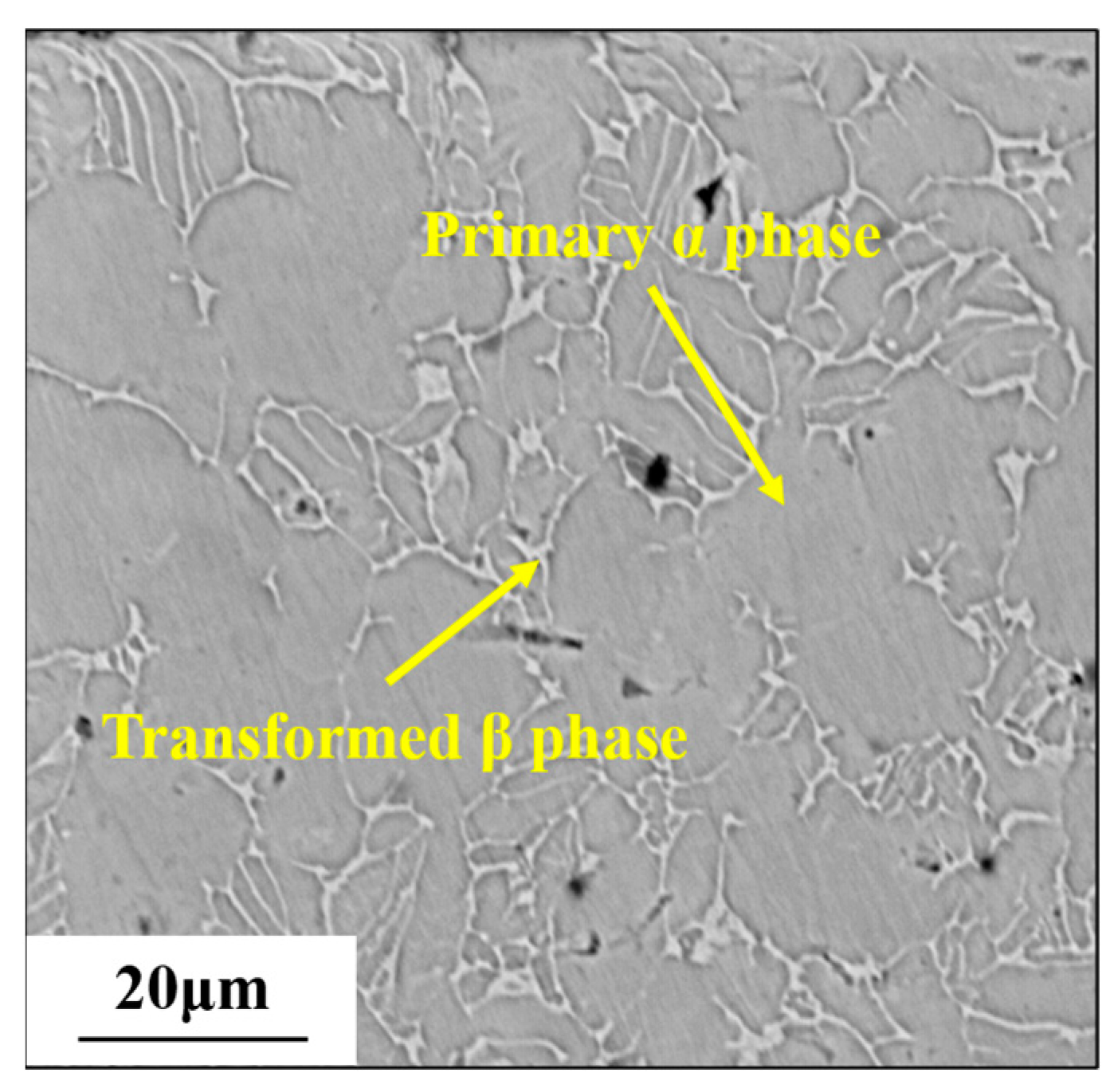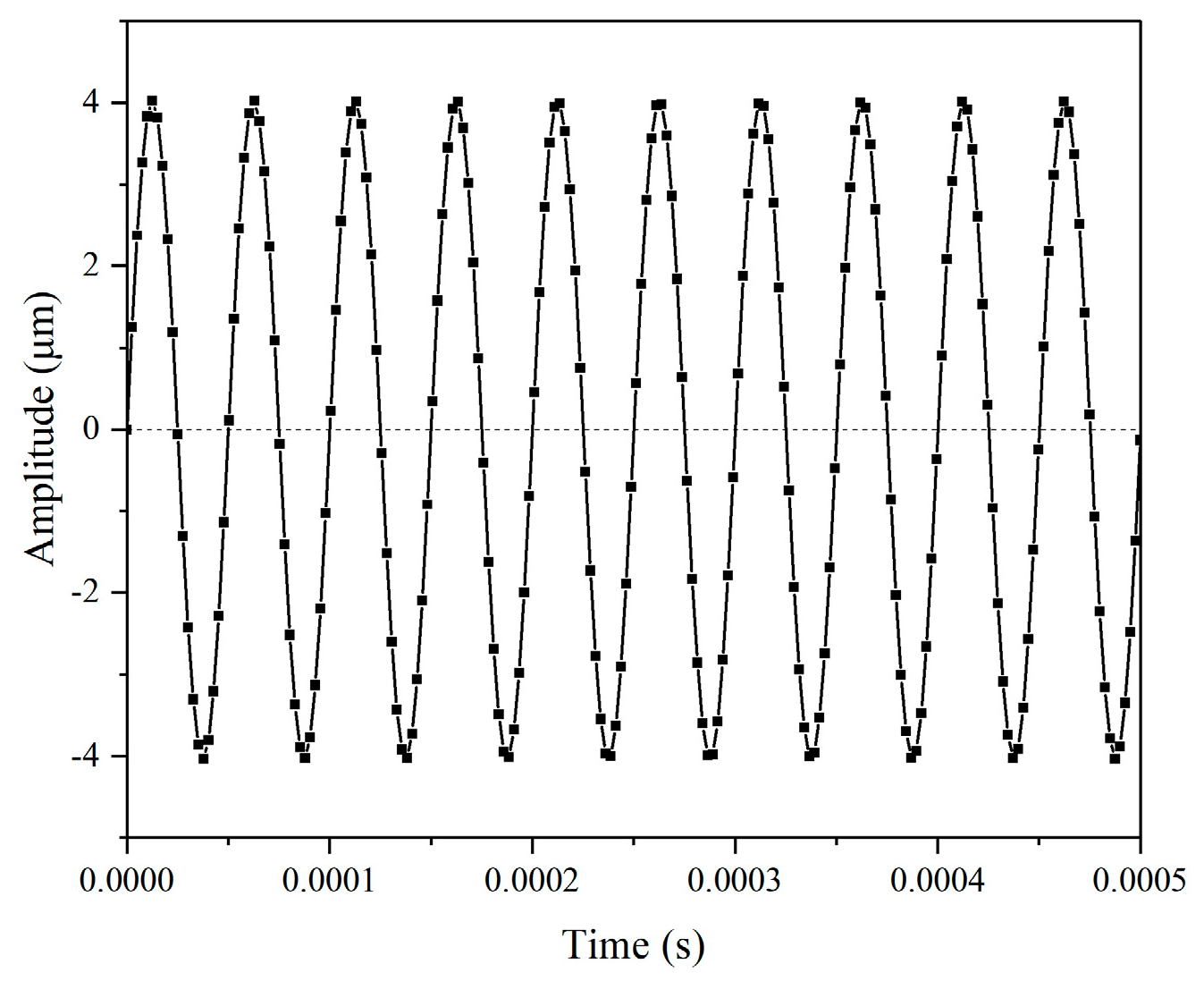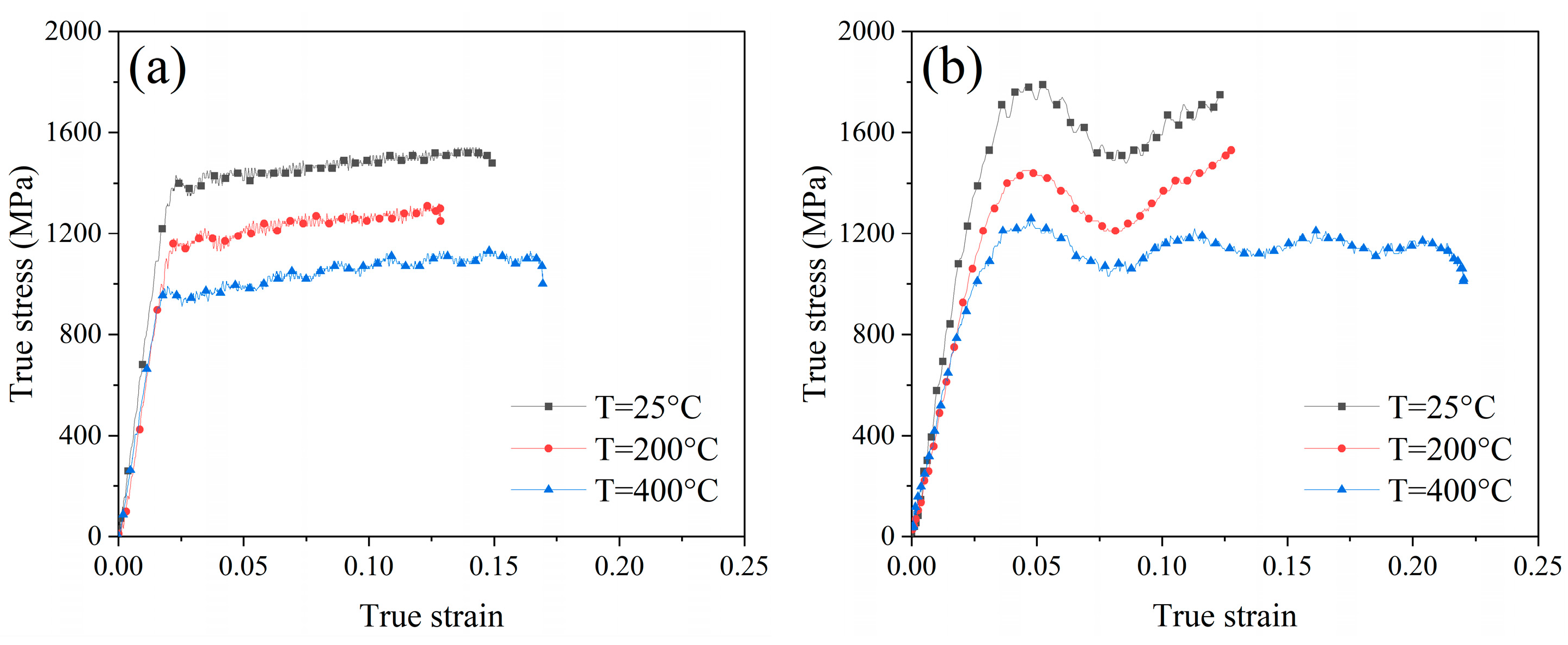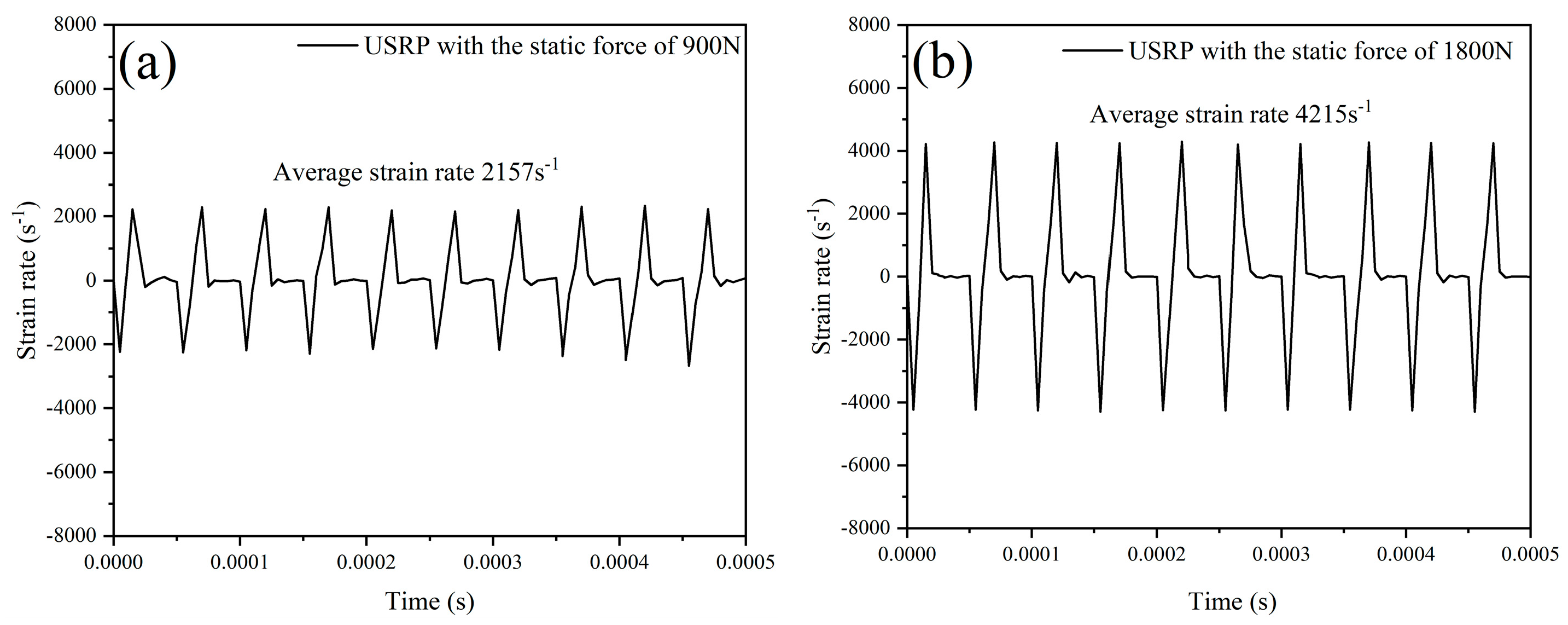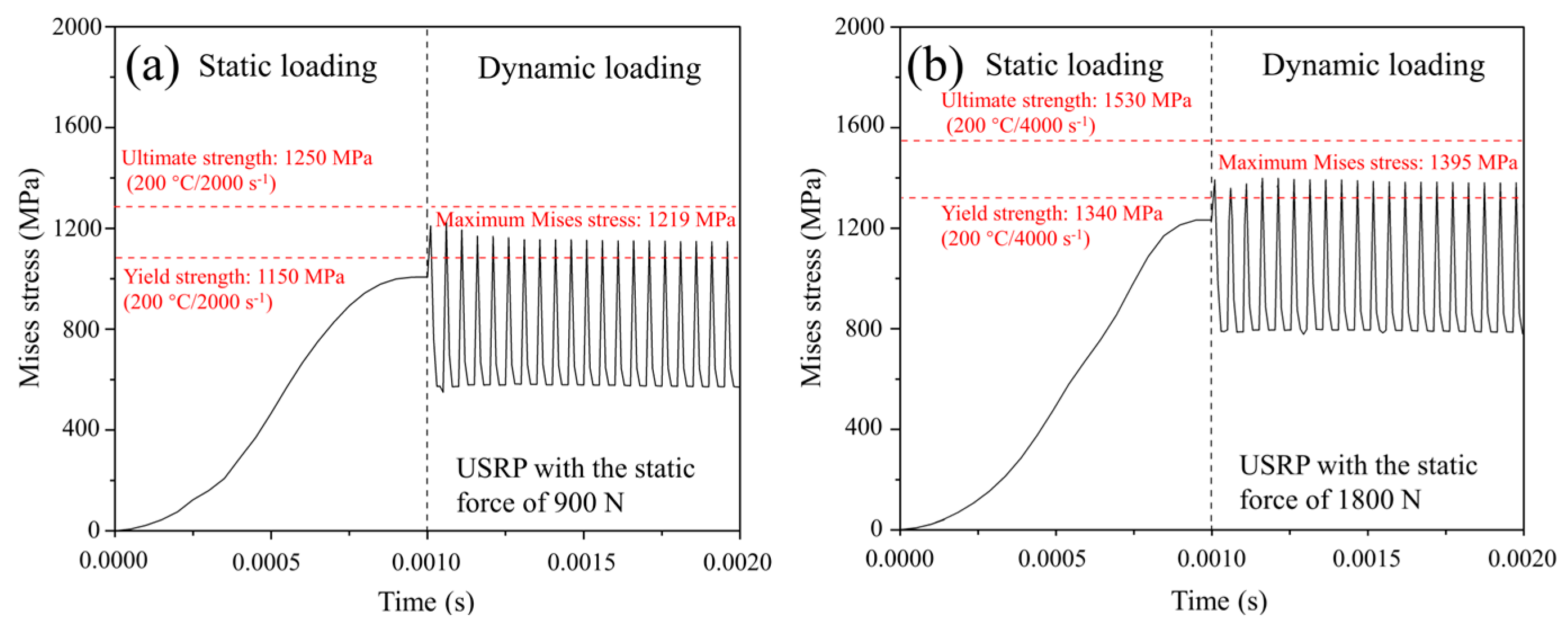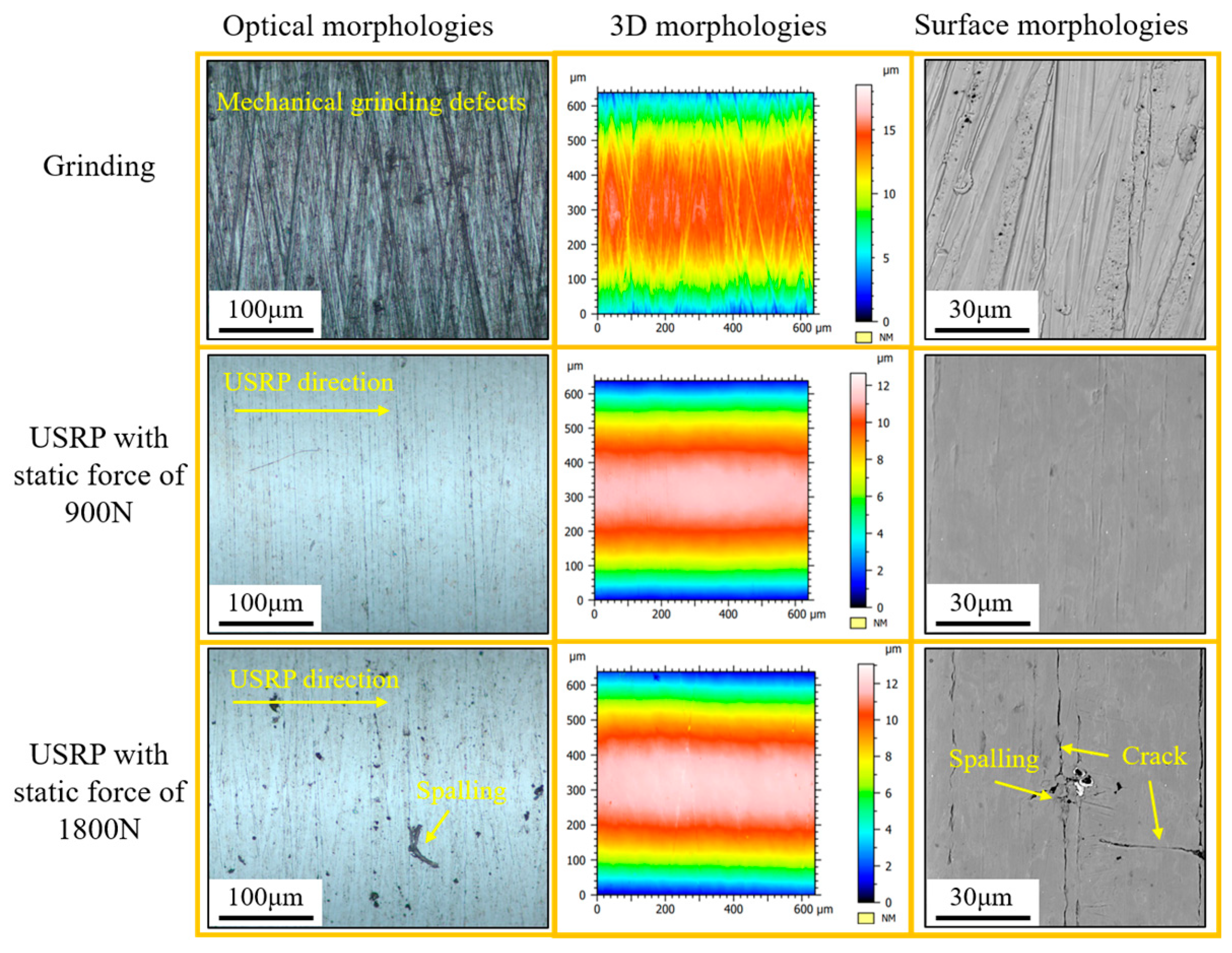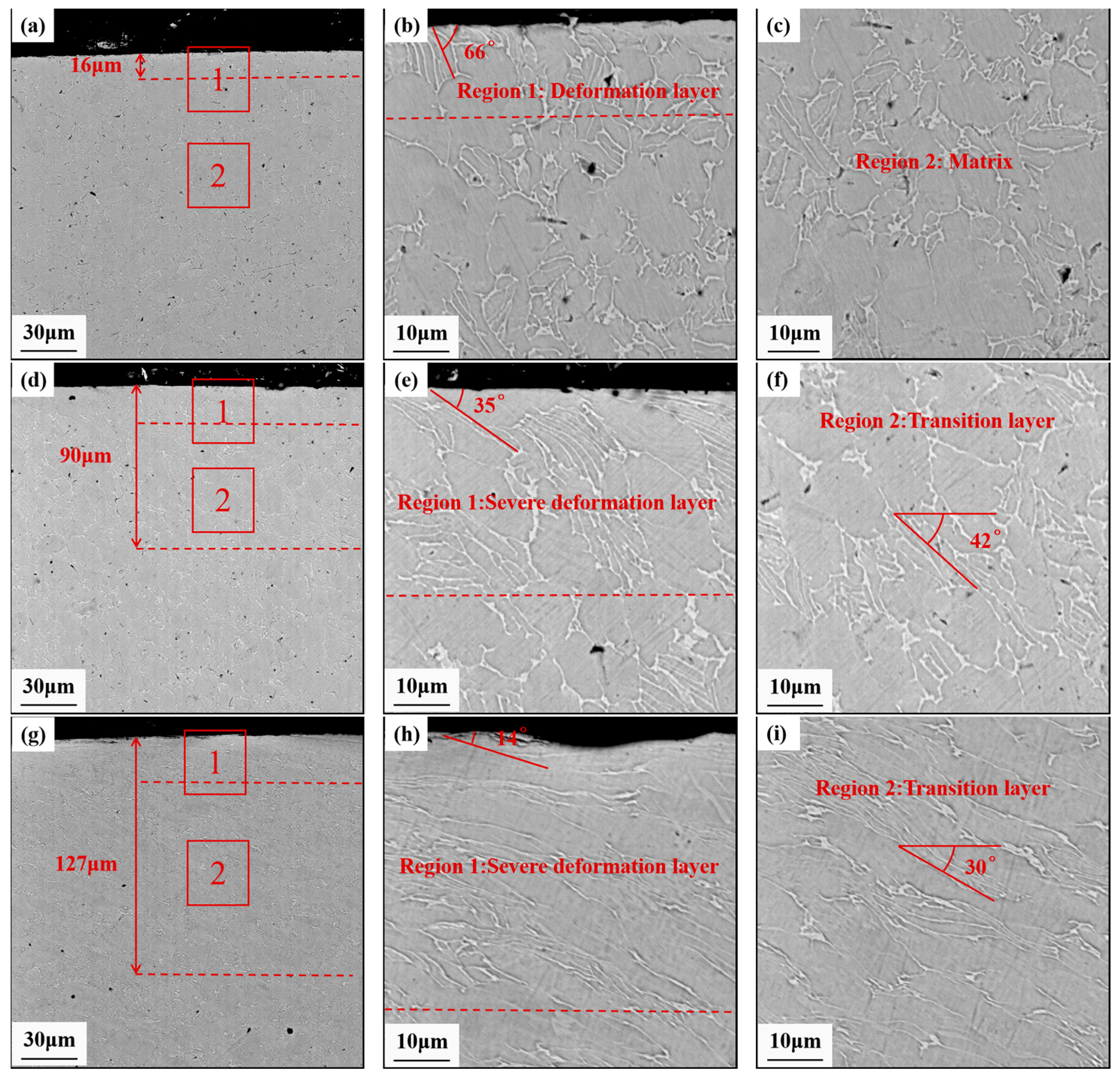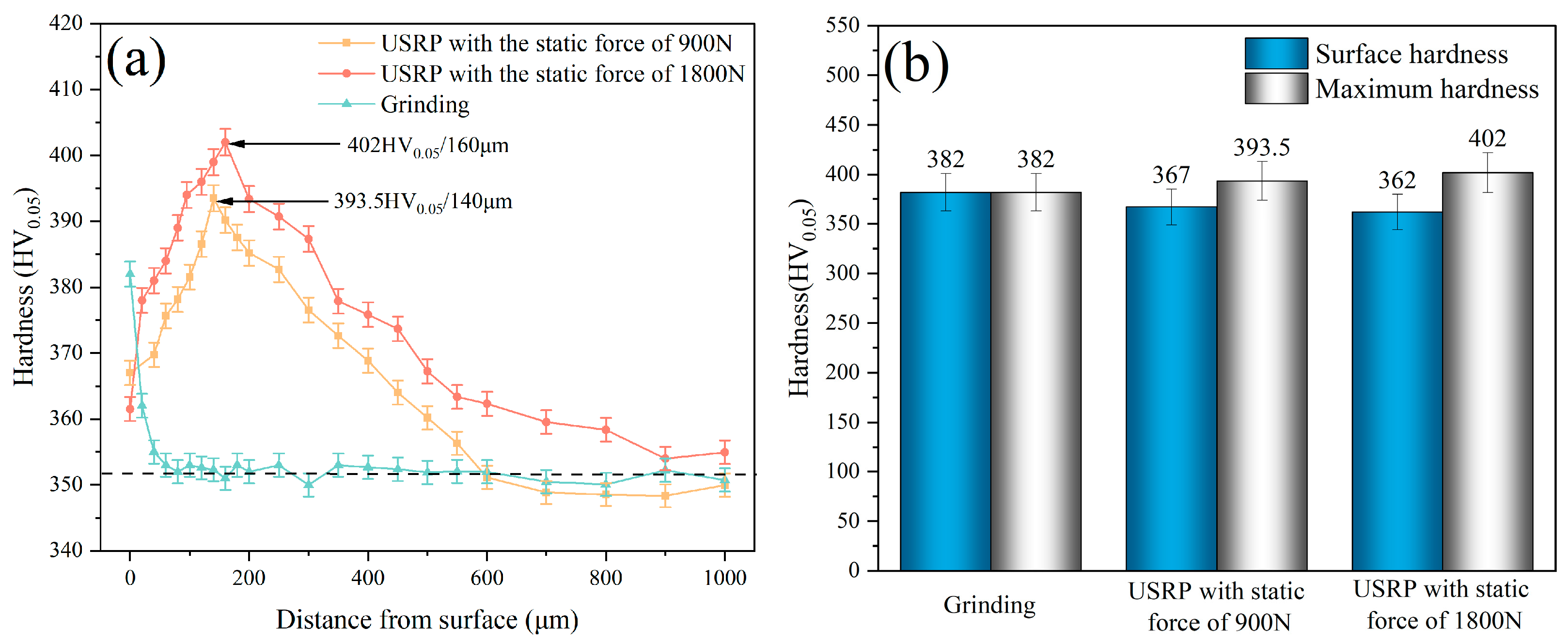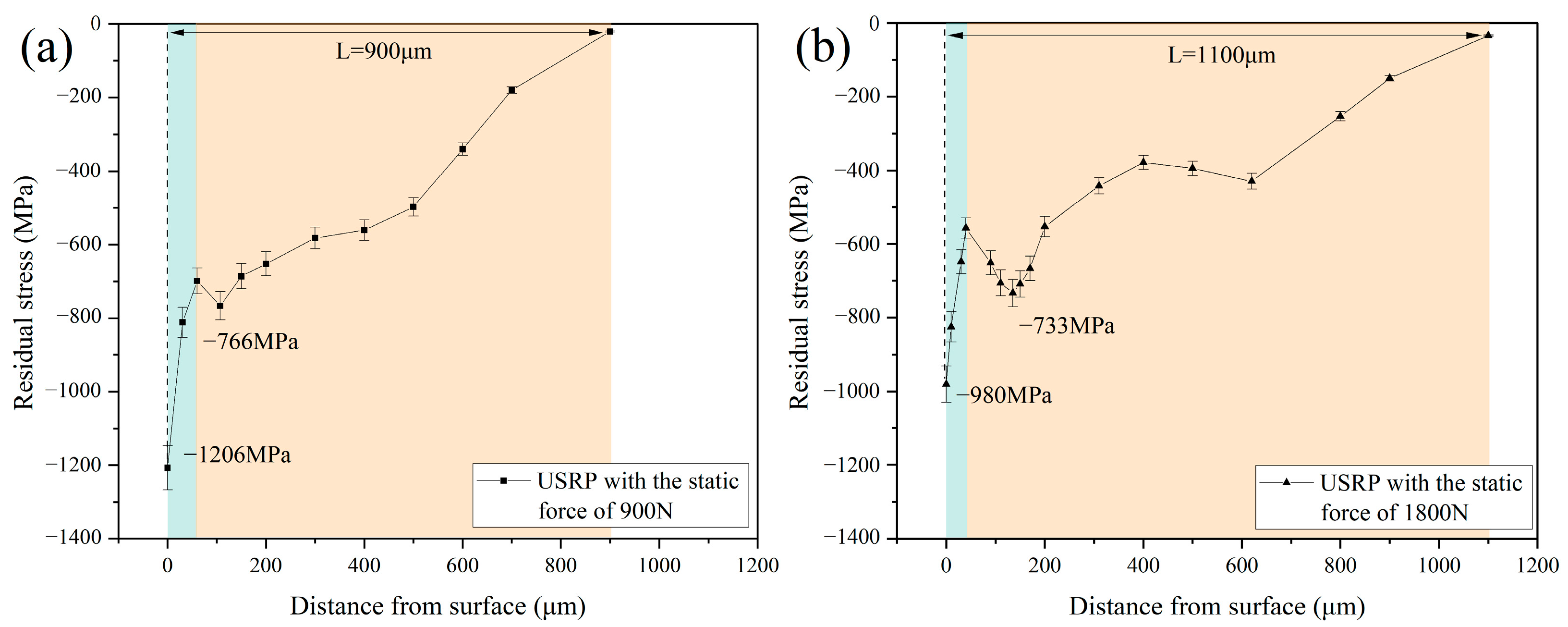1. Introduction
Titanium alloys fulfill the need for lightweight, high-strength, and corrosion-resistant material for modern manufacturing. As a result, the demand for titanium alloy has been increasing in aerospace [
1,
2], marine [
3,
4], and biomedical fields [
5,
6]. During the service period of titanium alloy components under complex conditions, fatigue failure is one of the main reasons for inducing damage and fracture of the components, which could result in serious consequences [
7]. Numerous studies have shown that surface strengthening methods have the potential to enhance the fatigue life of key components. The surface strengthening methods for practical engineering applications mainly consist of shot peening [
8], laser shock peening [
9], and ultrasonic surface rolling process [
10]. Shot peening has been commonly applied in scientific research and manufacturing because of its cost-effectiveness and suitability for processing complex-shaped components. By forming a residual compressive stress layer and a gradient layer on the material surface after shot peening, the fatigue performance of components was significantly improved. However, due to the randomness of the shot peening processing with many shots projected on the material, the formation of the residual compressive stress layer could be uneven distribution, and the surface quality could deteriorate. Laser shock peening involves using a high-energy laser beam to act on an absorbing layer attached to the surface of the workpiece material. This process generates a high-temperature, high-pressure plasma that causes localized expansion and explosion. The high-energy shock wave formed by localized expansion and explosion could operate on the workpiece surface under the constraint of a confinement layer. However, the pre-processing stage of the practical laser shock peening process is relatively complicated. Furthermore, the overall price of the laser shock strengthening equipment is very high, which leads to higher manufacturing costs. In contrast to the two strengthening techniques mentioned above, the ultrasonic surface rolling process (USRP) was characterized as the coupled influence of static force and dynamic ultrasonic impact force applied on the workpiece. The plastic deformation of the workpiece could be facilitated by an ultra-high-frequency (≥20 kHz) vibratory impact of the rolling ball, and the strain rate could achieve 10
2 s
−1 to 10
3 s
−1 during this condition [
11]. Simultaneously, the homogeneous surface deformation could be attributed to the rotational movement of the processed material [
12]. USRP could significantly decrease the surface roughness and raise the geometrical precision of the machined surface, thus greatly enhancing the machining quality. Additionally, USRP could promote the development of a gradient structure with the compressive residual stress field and work-hardening layer. Currently, USRP has effectively been utilized to enhance the fatigue properties of a variety of aerospace metals [
13,
14,
15], especially titanium alloys.
Based on the strain hardening theory, when the material surface was subjected to true stress that exceeded its yield strength, the micro-plastic deformation behavior could occur during USRP treatment. This could induce an increase in the internal dislocation density and a decrease in the grain size of the material subsurface so the mechanical properties of the workpiece material could be enhanced. It is of great significance to establish the correlation between the true thermo-mechanical behavior of the material and the ultrasonic surface rolling process of the workpiece. In recent years, some researchers have investigated the mutual influence relationship between the quasi-static mechanical properties and the ultrasonic impact strengthening process. Liu et al. [
16] simulated a single-point ultrasonic impact-strengthening process. The results demonstrated a positive correlation between the number of impacts, the rise in residual stress, and the corresponding plastic strain. The mechanical characteristics of the materials were measured under cyclic tensile-compression experiments at low strain rates. However, the strain rate of ultrasonic impact strengthening was approximately 10
2/s–10
3/s, so it could be hard to obtain the material response adequately under the high-velocity impact condition during USRP treatment. In addition, it was worth mentioning that the USRP was characterized as a conjunction of the static force and the dynamic ultrasonic impact force, causing a significant change in the transient velocity and acceleration of the rolling ball. As a result, plastic deformation with high strain rates was generated at the workpiece surface. The mechanical behavior of the material was significantly different between high strain rate deformation and quasi-static deformation conditions. Several scholars have developed material constitutive models to characterize the deformed behaviors of material based on experimental law. Liu et al. [
17] obtained the conventional J-C model of 18CrNiMo7-6 alloy steel by mechanical experiments at different strain rates. It found that the conventional J-C constitutive model could not precisely forecast the flow stress under high strain rate loading conditions. The error of stress value between the prediction and the test grew gradually as the strain rate increased. Thus, a revised J-C model was established. The strain rate strengthening coefficient was modified in a non-linear adjustment, taking into account the interdependence between strain and the strain-rate coefficients. At a strain rate of 3500/s, the average absolute relative error between the true stress predicted by the revised J-C model and the test of the true stress was reduced from 6.9% to 3.2%. The revised J-C model could accurately assess the high strain rate and mechanical behavior of 18CrNiMo7-6 alloy steel during USRP. Teimouri et al. [
18] established an analytical model of the ultrasonic surface burnishing process to investigate the consequences of various factors on the residual stress field. Two different constitutive models were chosen to validate the accuracy of this elastic–plastic analytical model, i.e., the J-C model, which was susceptible to strain rate, and the Chaboche hardening model, which was affected by cyclic loading. The results indicated that the J-C model showed more consistency in predicting the residual stress field, whereas the Chaboche hardening model underestimated the predictions. In addition, the forecast of the residual compressive stress field revealed that the depth and magnitude of compressive residual stress exhibited a positive correlation with the amplitude, static force, and ball diameter. In another work, Teimouri et al. [
19] established the concept of an elastoplastic cavity expansion model of materials (ECM) based on the physical model of the AA6061 aluminum alloy. The residual stress field was further calculated by this model with the aim of discovering the correlation between the amplitude and the residual stress field. The results indicated that raising the vibration amplitude value led to a greater degree of residual compressive stress introduction. Furthermore, it was found that augmenting the magnitude of vibration led to an increase in the strain rate at which the material surface underwent plastic deformation. Zhou et al. [
20] investigated the transient process by establishing a 3D FEM model of ultrasonic impact processing. It was noted that plastic deformation of the material did not occur with every single impact. This phenomenon only took place when the impact kinetic energy was above certain threshold levels. Increasing the velocity of the pin intensified the impact kinetic energy, resulting in significant plastic deformation of the workpiece. The maximum strain rate of a material undergoing plastic deformation during ultrasonic impact was 1300/s. Luan et al. [
11] conducted a Hopkinson pressure bar test to investigate the dynamic mechanical characteristics of 45CrNiMoVA steel at elevated temperatures. By extracting eigenvalues on the stress–strain curve, the relevance between dynamic mechanical characteristics and strain rate could be constructed. The findings demonstrated that the flow stress of 45CrNiMoVA reduced substantially as the temperature increased. The corresponding yield strength, ultimate strength, and modulus of elasticity exhibited a decreasing tendency. This indicated that the material surface was more susceptible to plastic deformation during the USRP at high temperatures, which could result in a deeper plastic deformation layer. Wu et al. [
21] established an analytical model and analyzed the relationship between static load and strain value during the ultrasonic impact. The static load could be determined from the maximum strain value between the yield strength and ultimate strength of the 20CrNiMo stress–strain curve. Chan et al. [
22] studied the microstructure of 304 stainless steel after ultrasonic peening by TEM and analyzed the association with the strain rate. The findings indicated that the high strain rate of plastic deformation could be conducive to producing a comparatively higher density of dislocations and nano-twins in the surface layer. According to the above research, it could be implied that the strain rate during high-speed impact surface treatment is essential to optimizing the microstructure of the surface layer, thus optimizing the mechanical properties of the workpiece. The optimal USRP parameter range could be determined depending on the thermo-mechanical performance of the material.
The service performance of the material after the USRP treatment was significantly improved. The current authors have reported that the strengthening mechanisms of material fatigue performance by the USRP treatment mainly included three reasons: (Ⅰ) USRP induced the residual compressive stress field at the workpiece surface, which could be helpful in inhibiting the beginning of fatigue crack and reducing the crack extension rate [
23,
24]; (Ⅱ) USRP caused grain refinement and hardness enhancement at the subsurface of the workpiece. The combined effect of the deep harden layer and grain refinement layer could effectively prevent fatigue crack propagation [
25,
26]; (Ⅲ) USRP further decreased the influence of stress concentration by reducing the surface roughness of the workpiece after the cutting process [
27,
28]. The reduction in stress concentration factor plays an essential function in increasing the fatigue properties of the workpiece. Zhao et al. [
29] discovered that USRP could form nanostructured grain boundaries on the surface of TC11 alloy, restricting the movement of dislocations and enhancing the difficulty of the initiation of the dislocation source. As a result, the resistance to deformation of the TC11 alloy has improved. The fatigue life was increased to 19.3% under the number of cycles with 5×10
6 in the fatigue testing. Dekhtyar et al. [
30] showed that the fatigue life of powder metallurgy Ti-6Al-4V alloy was extended approximately by a factor of 100 after USRP at fatigue cyclic stress amplitudes of 300–400 MPa. The increased fatigue strength and service life after the USRP could be attributed to modifications in the reduced surface roughness, the microstructure, and the residual stress state at the surface. In addition, the USRP could induce significant pore closure in the deformation layer about 200–250 μm thick, which had a beneficial effect on lifetime extension. Kattoura et al. [
31] studied the fatigue performance of the ATI718 alloy at elevated temperatures after ultrasonic nanocrystal surface modification (UNSM). The application of UNSM resulted in significant surface plastic deformation, causing the production of crystallites and twins at the nanoscale in the near-surface areas. This was accompanied by an increase in the hardness of the workpiece and the existence of substantial compressive residual stresses. The residual stresses in the material could be released at high temperatures, but these microstructures could remain stable at high temperatures. The yield strength and the fatigue strength were enhanced by 11% and 8%, respectively, in the fatigue testing at 650 °C because of the stable microstructure and retained residual stresses resulting from the UNSM treatment. As a result, UNSM could increase the fatigue resistance of the ATI718 alloy at high temperatures. This improvement might be caused by the synergistic influence of residual compressive stresses and temperature-stabilized work hardening.
The novelty of this work is to establish the correlation between the true thermo-mechanical behavior of the material and the USRP parameters of the workpiece. In this study, the Hopkinson pressure bar was utilized to investigate the dynamic deformation behavior of the Ti-6Al-4V alloy under thermo-mechanical processing. Additionally, the numerical simulation examined the evolution of the deformation strain rate and contact temperature between the rolling ball and Ti-6Al-4V material during the USRP. Combined with the results of the dynamic true stress–strain testing experiment, it could contribute to obtaining the relatively accurate deformation regularity of Ti-6Al-4V and investigating the strengthening mechanisms under the actual working conditions. Further, changes in the surface roughness, microstructure, hardness, and residual stress after USRP and rotational bending fatigue testing were analyzed utilizing scanning electron microscopy (SEM), laser scanning confocal microscope (LSM), X-ray diffraction (XRD), and so on. Fracture modes and mechanisms were also characterized by SEM to investigate the influence of USRP on fatigue life improvement.
